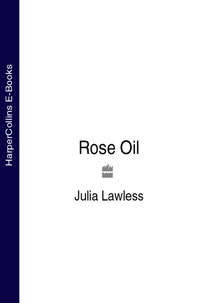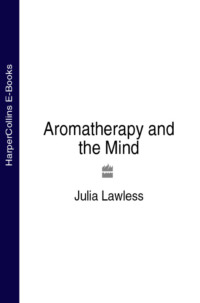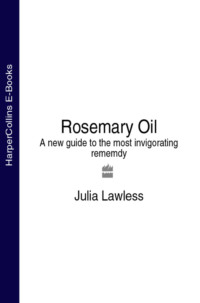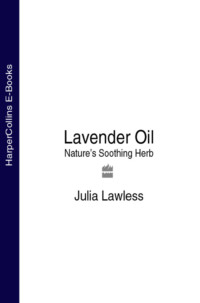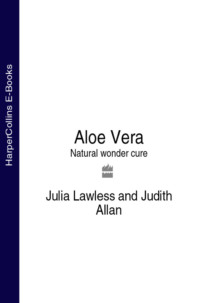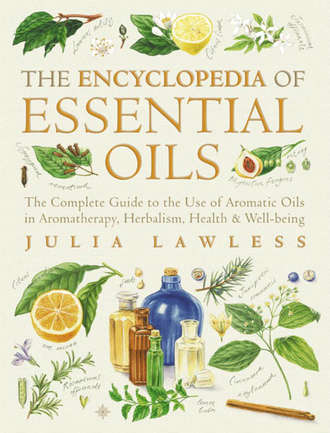
Полная версия
Encyclopedia of Essential Oils: The complete guide to the use of aromatic oils in aromatherapy, herbalism, health and well-being.
OTHER SPECIES There are many varieties of basil occurring all over the world, used both for their culinary and medicinal applications, such as bush basil (O. minimum), holy basil (O. sanctum), both from India, camphor basil (O. kilimanjaricum) from East Africa (also grown in India), and the fever plant (O. viride) from West Africa. However, there are two principal chemotypes most commonly used for the extraction of essential oil: the so-called ‘French basil’ and the ‘exotic basil’ – see separate entry.
HERBAL/FOLK TRADITION Widely used in Far Eastern medicine especially in the Ayurvedic tradition, where it is called tulsi. It is used for respiratory problems such as bronchitis, coughs, colds, asthma, ’flu and emphysema but is also used as an antidote to poisonous insect or snake bites. It has also been used against epidemics and fever, such as malaria. It improves blood circulation and the digestive system and in China it is used for stomach and kidney ailments.
In the West it is considered a ‘cooling’ herb, and is used for rheumatic pain, irritable skin conditions and for those of a nervous disposition. It is a popular culinary herb, especially in Italy and France.
ACTIONS Antidepressant, antiseptic, antispasmodic, carminative, cephalic, digestive, emmenagogue, expectorant, febrifuge, galactagogue, nervine, prophylactic, restorative, stimulant of adrenal cortex, stomachic, tonic.
EXTRACTION Essential oil by steam distillation from the flowering herb.
CHARACTERISTICS ‘True’ sweet basil oil is a colourless or pale yellow liquid with a light, fresh sweet-spicy scent and balsamic undertone. It blends well with bergamot, clary sage, lime, opopanax, oakmoss, citronella, geranium, hyssop and other ‘green’ notes.
PRINCIPAL CONSTITUENTS Linalol (40–45 per cent), methyl chavicol (23.8 per cent) and small amounts of eugenol, limonene and citronellol, among others.
SAFETY DATA Relatively non-toxic, non-irritant, possible sensitization in some individuals. Avoid during pregnancy.
AROMATHERAPY/HOME USE
Skin Care: Insect bites (mosquito, wasp), insect repellent.
Circulation, Muscles and Joints: Gout, muscular aches and pains, rheumatism.
Respiratory Syste: Bronchitis, coughs, earache, sinusitis.
Digestive System: Dyspepsia, flatulence, nausea.
Genito-Urinary System: Cramps, scanty periods.
Immune System: Colds, fever, ’flu, infectious disease.
Nervous System: Anxiety, depression, fatigue, insomnia, migraine, nervous tension: ‘Oil of Basil is an excellent, indeed perhaps the best, aromatic nerve tonic. It clears the head, relieves intellectual fatigue, and gives the mind strength and clarity.’8
OTHER USES The oil is used in soaps, cosmetics and perfumery; it is also used extensively in major food categories, especially savouries.
BAY, WEST INDIAN
Pimenta racemosa
FAMILY Myrtaceae
SYNONYMS Myrcia acris, Pimenta acris, myrcia, bay, bay rum tree, wild cinnamon, bayberry, bay leaf (oil).
GENERAL DESCRIPTION A wild-growing tropical evergreen tree up to 8 metres high, with large leathery leaves and aromatic fruits.
DISTRIBUTION Native to the West Indies, particularly Dominica where the essential oil is produced.
OTHER SPECIES There are several other varieties, for example the anise-scented and lemon-scented bay, the oils of which have a totally different chemical composition. Not to be confused with bay laurel, the common household spice, nor with the North American bayberry or wax myrtle (Myrcia cerifera) well known for its wax yielding berries.
HERBAL/FOLK TRADITION The West Indian bay tree is often grown in groves together with the allspice or pimento bush, then the fruits of both are dried and powdered for the preparation of the household allspice. The so-called bay rum tree also provides the basic ingredient for the famous old hair tonic, which is made from the leaves by being distilled in rum. ‘A hair application with both fragrant and tonic virtues … useful for those who suffer from greasy hair and need a spirit-based, scalp-stimulating lotion to help them to control their locks!’9
ACTIONS Analgesic, anticonvulsant, antineuralgic, antirheumatic, antiseptic, astringent, expectorant, stimulant, tonic (for hair).
EXTRACTION Essential oil by water or steam distillation from the leaves. An oleoresin is also produced in small quantities.
CHARACTERISTICS A dark yellow mobile liquid with a fresh-spicy top note and a sweet-balsamic undertone. It blends well with lavander, lavandin, rosemary, geranium, ylang ylang, citrus and spice oils.
PRINCIPAL CONSTITUENTS Eugenol (up to 56 per cent), myrcene, chavicol and, in lesser amounts, methyl eugenol, linalol, limonene, among others.
SAFETY DATA Moderately toxic due to high eugenol content; also a mucous membrane irritant – use in moderation only. Unlike bay laurel, however, it does not appear to cause dermal irritation or sensitization.
AROMATHERAPY/HOME USE
Skin Care: Scalp stimulant, hair rinse for dandruff, greasy, lifeless hair, and premoting growth.
Circulation, Muscles And Joints: Muscular and articular aches and pains, neuralgia, poor circulation, rheumatism, sprains, strains.
IMMUNE SYSTEM: Colds, ’flu, infectious diseases.
OTHER USES Extensively used in fragrance work, in soaps, detergents, perfumes, aftershaves and hair lotions, including bay rum. Employed as a flavour ingredient in many major food categories, especially condiments, as well as alcoholic and soft drinks.
BENZOIN
Styrax benzoin
FAMILY Styracaceae
SYNONYMS Gum benzoin, gum benjamin, styrax benzoin.
GENERAL DESCRIPTION A large tropical tree up to 20 metres high with pale green citrus-like leaves, whitish underneath, bearing hard-shelled flattish fruit about the size of a nutmeg. The benzoin is a pathological product, formed when the trunk is cut; the tree exudes a balsamic resin which hardens upon exposure, to air and sunlight.
DISTRIBUTION Native to tropical Asia; the two main regions of production are Sumatra, Java and Malaysia for ‘Sumatra’ benzoin, and Laos, Vietnam, Cambodia, China and Thailand for ‘Siam’ benzoin.
OTHER SPECIES There are many different varieties within the Styrax family which produce benzoin, but these are generally classified under either Sumatra benzoin (S. paralleloneurus) or Siam benzoin (S. tonkinensis) – see also Botanical Classification section.
HERBAL/FOLK TRADITION It has been used for thousands of years in the east as a medicine and incense; the fumigations were believed to drive away evil spirits. It was used by the Chinese herbalists for its heating and drying qualities, as a good urinary antiseptic and as an aid to digestion.
In the west, it is best known in the form of compound tincture of benzoin or Friars Balsam, used for respiratory complaints. Externally it is used for cuts and irritable skin conditions; internally it is used as a carminative for indigestion, etc. It also acts as a preservative of fats.
ACTIONS Anti-inflammatory, anti-oxidant, antiseptic, astringent, carminative, cordial, deodorant, diuretic, expectorant, sedative, styptic, vulnerary.
EXTRACTION The crude benzoin is collected from the trees directly. Benzoin resinoid, or ‘resin absolute’, is prepared from the crude using solvents, for example benzene and alcohol, which are then removed. Commercial benzoin is usually sold dissolved in ethyl glycol or a similar solvent. A ‘true’ absolute is also produced in small quantities.
CHARACTERISTICS 1. Sumatra crude benzoin occurs as greyish-brown brittle lumps with reddish streaks, with a styrax-like odour. There are several different qualities available; the so-called ‘almond’ grade is considered superior. 2. Siam benzoin comes in pebble or tear-shaped orange-brown pieces, with a sweet-balsamic vanilla-like scent, this type having a more refined odour than the Sumatra type.
Benzoin resinoid is produced from both the Siam and Sumatra types, or a mix of the two. It is an orange-brown viscous mass with an intensely rich sweet-balsamic odour. It blends well with sandalwood, rose, jasmine, copaiba balsam, frankincense, myrrh, cypress, juniper, lemon, coriander and other spice oils.
PRINCIPAL CONSTITUENTS 1. Sumatra Benzoin: mainly coniferyl cinnamate and sumaresinolic acid, with benzoic acid, cinnamic acid, and traces of styrene, vanillin and benzaldehyde. 2. Siam benzoin: mainly coniferyl benzoate (65–75 per cent), with benzoic acid, vanillin, siaresinolic acid and cinnamyl benzoate.
SAFETY DATA Non-toxic, non-irritant, possible sensitization. Compound benzoin tincture is ‘regarded as moderately toxic, due probably to occasional contact dermatitis developed in some individuals … which contains, in addition to benzoin, aloe, storax, Tolu balsam and others.’10
AROMATHERAPY/HOME USE
Skin Care: Cuts, chapped skin, inflamed and irritated conditions.
Circulation, Muscles And Joints: Arthritis, gout, poor circulation, rheumatism.
Respiratory System: Asthma, bronchitis, chills, colic, coughs, laryngitis.
Immune System: ’Flu.
Nervous System: Nervous tension and stress-related complaints. It warms and tones the heart and circulation, both physically and metaphorically: ‘This essence creates a kind of euphoria; it interposes a padded zone between us and events.’11
OTHER USES Compound benzoin tincture is used in pharmaceuticals and in dentistry to treat gum inflammation. The resinoid and absolute are used extensively as fixatives and fragrance components in soaps, cosmetics, toiletries and perfumes, especially Siam benzoin. Both types are used in most food categories, including alcoholic and soft drinks.
BERGAMOT
Citrus bergamia
FAMILY Rutaceae
SYNONYM Citrus aurantium subsp. bergamia.
GENERAL DESCRIPTION A small tree, about 4.5 metres high with smooth oval leaves, bearing small round fruit which ripen from green to yellow, much like a miniature orange in appearance.
DISTRIBUTION Native to tropical Asia. Extensively cultivated in Calabria in southern Italy and also grown commercially on the Ivory Coast.
OTHER SPECIES Not to be confused with the herb bergamot or bee balm (Monarda didyma).
HERBAL/FOLK TRADITION Named after the Italian city of Bergamo in Lombardy, where the oil was first sold. The oil has been used in Italian folk medicine for many years, primarily for fever (including malaria) and worms; it does not feature in the folk tradition of any other countries. However, due to recent research in Italy, bergamot oil is now known to have a wide spectrum of applications, being particularly useful for mouth, skin, respiratory and urinary tract infections.
ACTIONS Analgesic, anthelmintic, antidepressant, antiseptic (pulmonary, genito-urinary), antispasmodic, antitoxic, carminative, digestive, diuretic, deodorant, febrifuge, laxative, parasiticide, rubefacient, stimulant, stomachic, tonic, vermifuge, vulnerary.
EXTRACTION Essential oil by cold expression of the peel of the nearly ripe fruit. (A rectified or terpeneless oil is produced by vacuum distillation or solvent extraction.)
CHARACTERISTICS A light greenish-yellow liquid with a fresh sweet-fruity, slightly spicy-balsamic undertone. On ageing it turns a brownish-olive colour. It blends well with lavender, neroli, jasmine, cypress, geranium, lemon, chamomile, juniper, coriander and violet.
PRINCIPAL CONSTTTUENTS Known to have about 300 compounds present in the expressed oil: mainly linalyl acetate (30–60 per cent), linalol (11–22 per cent) and other alcohols, sesquiterpenes, terpenes, alkanes and furocoumarins (including bergapten, 0.30–0.39 per cent).
SAFETY DATA Certain furocoumarins, notably bergapten, have been found to be phototoxic on human skin; that is, they cause sensitization and skin pigmentation when exposed to direct sunlight (in concentration and in dilution even after some time!). Extreme care must be taken when using the oil in dermal applications – otherwise a rectified or ‘bergapten-free’ oil should be substituted. Available information indicates it to be otherwise non-toxic and relatively non-irritant.
AROMATHERAPY/HOME USE
Skin Care: Acne, boils, cold sores, eczema, insect repellent and insect bites, oily complexion, psoriasis, scabies, spots, varicose ulcers, wounds.
Respiratory System: Halitosis, mouth infections, sore throat, tonsillitis.
Digestive System: Flatulence, loss of appetite.
Genito-URINARY SYSTEM: Cystitis, leucorrhoea, pruritis, thrush.
Immune System: Colds, fever, ’flu, infectious diseases.
Nervous System: Anxiety, depression and stress-related conditions, having a refreshing and uplifting quality.
OTHER USES Extensively used as a fragrance and, to a degree, a fixative in cosmetics, toiletries, suntan lotions and perfumes – it is a classic ingredient of eau-de-cologne. Widely used in most major food categories and beverages, notably Earl Grey tea.
BIRCH, SWEET
Betula lenta
FAMILY Betulaceae
SYNONYMS B. capinefolia, cherry birch, southern birch, mahogany birch, mountain mahogany.
GENERAL DESCRIPTION A graceful tree about 25 metres high which has a pyramidal shape while young. It has bright green leaves and a dark reddish-brown aromatic bark, which is broken into plates or patches.
DISTRIBUTION Native to southern Canada and southeastern USA; produced mainly in Pennsylvania.
OTHER SPECIES There are numerous species of birch, spanning several continents, such as black birch (B. nigra) found in North America. Not to be confused with the European white birch (B. alba), which produces birch tar oil used in chronic skin diseases.
HERBAL/FOLK TRADITION The cambium (the layer directly under the bark) is eaten in the spring, cut into strips like vermicelli. The bark, in the form of an infusion, is used as a general stimulant and to promote sweating. As a decoction or syrup, it is used as a tonic for dysentery and is said to be useful in genito-urinary irritation. The flavour of wintergreen and birch bark, in the form of a tea, was popular with the American Indians and European settlers. More recently, this has been translated into a preference for ‘root beer’ flavourings.
ACTIONS Analgesic, anti-inflammatory, antipyretic, antirheumatic, antiseptic, astringent, depurative, diuretic, rubefacient, tonic.
EXTRACTION Essential oil by steam distillation of the bark macerated in warm water.
CHARACTERISTICS Colourless, pale yellow or reddish tinted liquid with an intense, sweet-woody, wintergreen-like scent.
PRINCIPAL CONSTITUENTS Almost entirely methyl salicylate (98 per cent), produced during the maceration process. It is almost identical in composition to wintergreen oil.
SAFETY DATA Methyl salicylate, the major constituent, is not exactly toxic but very harmful in concentration.’ It can be absorbed through the skin, and fatal poisoning via this route has been reported.’12’ It is also classed as an enviromental hazard or marine pollutant.
AROMATHERAPY/HOME USE None.
OTHER USES Limited use as a counter-irritant in anti-arthritic and antineuralgic ointments and analgesic balms. Limited use as a fragrance component in cosmetics and perfumes; extensively used as a flavouring agent, especially ‘root beer’, chewing gum, toothpaste, etc. (usually very low-level use).
BIRCH, WHITE
Betula alba
FAMILY Betulaceae
SYNONYMS B. alba var. pubescens, B. odorata, B. pendula, European white birch, silver birch.
GENERAL DESCRIPTION Decorative tree, up to 15–20 metres high, with slender branches, silvery-white bark broken into scales, and light green oval leaves. The male catkins are 2–5 cms long, the female up to 15 cms long.
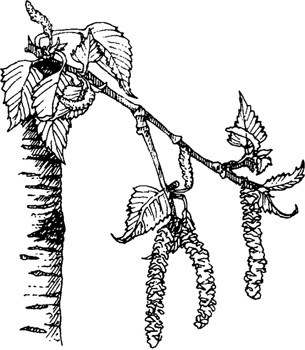
White Birch
DISTRIBUTION Native to the northern hemisphere; found throughout Eastern Europe, Russia, Germany, Sweden, Finland, the Baltic coast, northern China and Japan.
OTHER SPECIES Many cultivars exist of this species of birch. The paper birch (B. papyrifera) and B. verrucosa are also used for the production of birch bud oil and/or birch tar. NB Should not be confused with the oil from the sweet birch (B. lenta) which is potentially toxic.
HERBAL/FOLK TRADITION Birch buds were formerly used as a tonic in hair preparations. Birch tar is used in Europe for all types of chronic skin complaints: psoriasis, eczema, etc. In Scandinavia the young birch leaflets and twigs are bound into bundles and used in the sauna to tone the skin and promote the circulation. The sap is also tapped in the spring and drunk as a tonic. Buds, leaves and bark are used for ‘rheumatic and arthritic conditions, especially where kidney functions appear to need support … oedematous states; urinary infections and calculi.’13
ACTIONS Anti-inflammatory, antiseptic, cholagogue, diaphoretic, diuretic, febrifuge, tonic.
EXTRACTION 1. Essential oil by steam distillation from the leaf-buds. 2. Crude birch tar is extracted by slow destructive distillation from the bark; this is subsequently steam distilled to yield a rectified birch tar oil.
CHARACTERISTICS 1. Pale yellow, viscous oil with a woody-green balsamic scent. It crystallizes at low temperatures. 2. The crude tar is an almost black, thick oily mass. The rectified oil is a brownish-yellow, clear oily liquid with a smoky, tar-like, ‘Russian leather’ odour. It blends well with other woody and balsamic oils.
PRINCIPAL CONSTITUENTS 1. Mainly betulenol and other sesquiterpenes. 2. In the tar oil: phenol, cresol, xylenol, guaiacol, creosol, pyrocatechol, pyrobetulin (which gives the ‘leather’ scent).
SAFETY DATA Non-toxic, non-irritant, non-sensitizing.
AROMATHERAPY/HOME USE
Skin Care: Dermatitis, dull or congested skin, eczema, hair care, psoriasis etc.
Circulation Muscles And Joints: Accumulation of toxins, arthritis, cellulitis, muscular pain, obesity, oedema, poor circulation, rheumatism.
OTHER USES Birch bud oil is used primarily in hair tonics and shampoos, and in some cosmetics for its potential skin-healing effects. The crude tar is used in pharmaceutical preparations, ointments, lotions, etc. for dermatological diseases. It is also used in soap and leather manufacture – rectified birch tar oil provides the heart for many ‘leather’ type perfumes and aftershaves.
BOLDO LEAF
Peumus boldus
FAMILY Monimiaceae
SYNONYMS Boldu boldus, Boldoa fragrans, boldus, boldu.
GENERAL DESCRIPTION An evergreen shrub or small tree up to 6 metres high, with slender branches, sessile coarse leaves and bearing yellowish-green fruit; when dried the leaves turn a deep reddish-brown colour. The whole plant is aromatic.
DISTRIBUTION Native to Chile; naturalized in the Mediterranean region. Some essential oil is produced in Nepal and Vietnam.
OTHER SPECIES The Australian tree Monimia rotundifolia contains a similar oil, which has been used as a substitute. The oil of chenopodium or wormseed is also chemically related.
HERBAL/FOLK TRADITION The bark is used for tanning, the wood utilized in charcoal making and the fruit eaten by locals. In South America it has long been recognized as a valuable cure for gonorrhoea. In Western herbalism, the dried leaves are used for genito-urinary inflammation, gallstones, liver or gall bladder pain, cystitis and rheumatism. The dried leaves are current in the British Herbal Pharmacopoeia as a specific for cholelithiasis with pain.
ACTIONS Antiseptic, cholagogue, diaphoretic, diuretic, hepatic, sedative, tonic, urinary demulcent.
EXTRACTION Essential oil by steam distillation of the leaves.
CHARACTERISTICS A yellow liquid with a powerful spicy-camphoraceous, disagreeable odour.
PRINCIPAL CONSTITUENTS Cymene, ascaridole, cineol, linalol.
SAFETY DATA Extremely toxic. ‘The oil has powerful therapeutic effects, and it can be considered harmful to the human organism even when used in very small doses … should not be used in therapy, either internally or externally.’14
AROMATHERAPY/HOME USE None.
OTHER USES Used in pharmaceuticals in minute amounts for its therapeutic properties.
BORNEOL
Dryobalanops aromatica
FAMILY Dipterocarpaceae
SYNONYMS D. camphora, Borneo camphor, East Indian camphor, Baros camphor, Sumatra camphor, Malayan camphor.
GENERAL DESCRIPTION The camphora tree grows to a great height, a majestic tree often over 25 metres high, with a thick trunk up to 2 metres in diameter. Borneol is a natural exudation found beneath the bark in crevices and fissures of some mature trees (about 1 per cent); young trees produce only a clear yellow liquid known as ‘liquid camphor’.
DISTRIBUTION Native to Borneo and Sumatra.
OTHER SPECIES To be distinguished from the Japanese or Formosa type of camphor, more commonly used in Europe, which is relatively toxic. See also Botanical Classification section.
HERBAL/FOLK TRADITION Borneol has long been regarded as a panacea by many Eastern civilizations, especially in ancient Persia, India and China. It was used as a powerful remedy against plague and other infectious diseases, stomach and bowel complaints. In China it was also used for embalming purposes. ‘It is mentioned by Marco Polo in the thirteenth century and Camoens in 1571 who called it the “balsam of disease”.’15 It is valued for ceremonial purposes in the east generally, and in China particularly for funeral rites. Its odour repels insects and ants, and it is therefore highly regarded as timber for the construction of buildings.




